外研版小学英语四年级上册知识梳理
- 格式:docx
- 大小:102.89 KB
- 文档页数:15
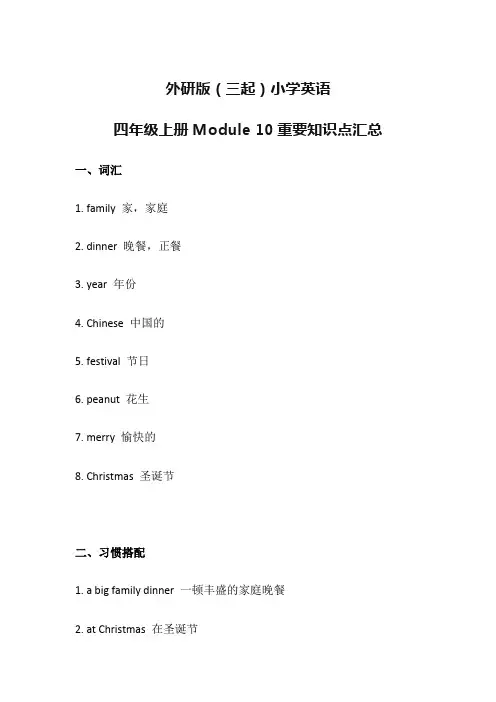
外研版(三起)小学英语四年级上册Module 10重要知识点汇总一、词汇1. family 家,家庭2. dinner 晚餐,正餐3. year 年份4. Chinese 中国的5. festival 节日6. peanut 花生7. merry 愉快的8. Christmas 圣诞节二、习惯搭配1. a big family dinner 一顿丰盛的家庭晚餐2. at Christmas 在圣诞节3. the Spring Festival 春节4. New Year 新年三、惯用表达1. I see. 我明白了。
2. Happy New Year! 新年快乐!3. Merry Christmas! 圣诞快乐!四、重点句型1. At / On + 节日名称, We + 动词(短语)原形(+ 其他).举例:At the Spring Festival, we have a big family dinner.在春节,我们吃一顿丰盛的家庭晚餐。
举例:At the Dragon Boat Festival, we eat zongzi and have dragon boat races. 在端午节,我们吃粽子,举行龙舟比赛。
2. –What do you do at / on + 节日?–I / We + 动词(短语)原形(+ 其他).问:What do you do at Christmas? 在圣诞节你们做什么?答:We sing songs. 我们唱歌。
问:What do you do at the Spring Festival? 在春节你做什么?答:I eat dumplings with my family. 我和我的家人一起吃饺子。

完整版)外研版四年级英语上册复习知识点归纳总结3)listen to music听音乐4)talk to XXX和朋友交谈5)run fast跑得快6)look at the picture看图片7)play football踢足球3.句子1)I like XXX.我喜欢读书。
2)She is taking pictures of the flowers.她在拍花的照片。
3)XXX.我们在听音乐。
4)XXX his XXX.他正在和他的朋友交谈。
5)They are running fast.他们跑得很快。
6)Look at the picture.看一下这张图片。
7)XXX让我们一起踢足球。
Module 31.单词happy高兴的sad伤心的angry生气的XXX疲倦的hungry饿的thirsty口渴的XXX困的excited兴奋的bored无聊的2.短语1)be happy高兴2)be sad伤心3)be angry生气4)be tired疲倦5)be hungry饥饿6)be XXX口渴7)be excited兴奋8)be bored无聊3.句子1)I am happy today.今天我很开心。
2)She is sad because she lost her toy.她因为丢失了她的玩具而伤心。
3)He is angry with his XXX.他对他的兄弟生气。
4)I am tired after running for an hour.我跑了一个小时后很累。
5)She is hungry and wants to eat something.她很饿,想吃点东西。
6)He is XXX and needs a XXX.他口渴了,需要喝水。
7)I am XXX party.我对我的生日派对感到兴奋。
8)They are bored with the movie.他们对这部电影感到无聊。
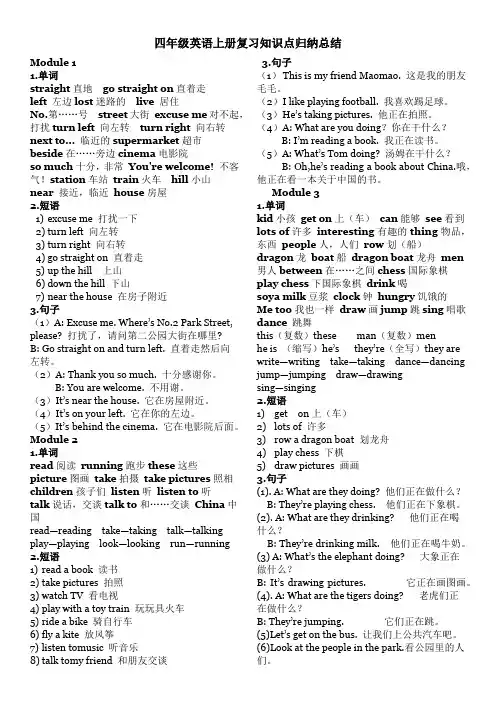
四年级英语上册复习知识点归纳总结Module 11.单词straight直地go straight on直着走left 左边lost迷路的live居住No.第……号street大街excuse me对不起,打扰turn left向左转turn right向右转next to... 临近的supermarket超市beside在……旁边cinema电影院so much十分,非常You're welcome!不客气!station车站train火车hill小山near接近,临近house房屋2.短语1)excuse me 打扰一下2)turn left 向左转3)turn right 向右转4)go straight on 直着走5)up the hill 上山6)down the hill 下山7)near the house 在房子附近3.句子(1)A: Excuse me. Where’s No.2 Park Street, please? 打扰了,请问第二公园大街在哪里?B: Go straight on and turn left. 直着走然后向左转。
(2)A: Thank you so much. 十分感谢你。
B: You are welcome. 不用谢。
(3)It’s near the house. 它在房屋附近。
(4)It’s on your left. 它在你的左边。
(5)It’s behind the cinema. 它在电影院后面。
Module 21.单词read阅读running跑步these这些picture图画take拍摄take pictures照相children孩子们listen听listen to听talk说话,交谈talk to和……交谈China中国read—reading take—taking talk—talking play—playing look—looking run—running 2.短语1)read a book 读书2)take pictures 拍照3)watch TV 看电视4)play with a toy train 玩玩具火车5)ride a bike 骑自行车6)fly a kite 放风筝7)listen tomusic 听音乐8)talk tomy friend 和朋友交谈3.句子(1)This is my friend Maomao. 这是我的朋友毛毛。
![全]外研版(三起)小学英语四年级上册知识点归纳总结](https://uimg.taocdn.com/425c03e86e1aff00bed5b9f3f90f76c661374cd0.webp)
全]外研版(三起)小学英语四年级上册知识点归纳总结Module 1:In Module 1.we learn about words that express n and n。
such as "left," "right," "next to," "beside," and "near." We also learn some common places。
like "street," "supermarket," "n," "cinema," and "house." nally。
we learn about the phrase "live at," the use of "turn left/right," and the n "thank you so much." The key sentence structure we learn is "Where is。
" followed by "It's + n."Module 2:In Module 2.we learn about verbs like "read," "take," "listen," and "talk," as well as the noun "picture" and the plural form of "child." We also learn about the phrase "take pictures," and common activities like "play with," "listen to," "look at," "talk to," "read a book," "play football," and "watch TV." There are no new XXX.XXX's Day OutMary is a young girl who is having a fun day out with her family。
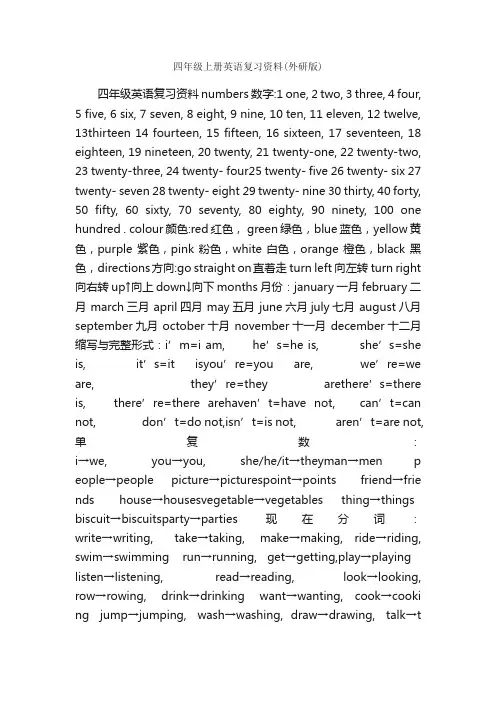
四年级上册英语复习资料(外研版)四年级英语复习资料numbers数字:1 one, 2 two, 3 three, 4 four, 5 five, 6 six, 7 seven, 8 eight, 9 nine, 10 ten, 11 eleven, 12 twelve, 13thirteen 14 fourteen, 15 fifteen, 16 sixteen, 17 seventeen, 18 eighteen, 19 nineteen, 20 twenty, 21 twenty-one, 22 twenty-two, 23 twenty-three, 24 twenty- four25 twenty- five 26 twenty- six 27 twenty- seven 28 twenty- eight 29 twenty- nine 30 thirty, 40 forty, 50 fifty, 60 sixty, 70 seventy, 80 eighty, 90 ninety, 100 one hundred . colour颜色:red红色, green绿色,blue蓝色,yellow黄色,purple紫色,pink粉色,white白色,orange橙色,black黑色,directions方向:go straight on直着走 turn left 向左转 turn right 向右转up↑向上down↓向下months月份:january一月 february二月 march三月 april四月 may五月 june六月july七月 august八月september九月 october十月 november十一月 december十二月缩写与完整形式:i’m=i am, he’s=he is, she’s=she is, it’s=it isyou’re=you are, we’re=we are, they’re=they arethere’s=there is, there’re=there arehaven’t=have not, can’t=can not, don’t=do not,isn’t=is not, aren’t=are not,单复数:i→we,you→you,she/he/it→theyman→men p eople→people picture→picturespoint→points friend→frie nds house→housesvegetable→veget ables thing→things biscuit→biscuitsparty→parties现在分词:write→writing,take→taking, make→making,ride→riding, swim→swimming run→running, get→getting,play→playing listen→listening,read→reading,look→looking, row→rowing,drink→d rinking want→wanting,cook→cooki ng jump→jumping,wash→washing, draw→drawing, talk→talking,,。

外研版四年级英语上册知识总结姓名:Module 11.go straight on 直着走2.turn left 向左转turn right 向右转3.excuse me 对不起,打扰一下4.next to 贴近,紧靠...旁边so much 十分,非常5.at the station 在车站up the hill 上山down the hill 下山6.询问某个地方位置的句型:Where + be动词+ 主语?例句:——Excuse me, Where’s the school, please?打扰一下,请问学校在哪里?——Go straight on......7.表示感谢的句型:问句:——Thank you so much! 非常感谢!答语:——You’re welcome. 不客气。
Module 21.take pictures 照相listen to music 听音乐talk to 和......交谈watch TV 看电视read a book 看书write a letter 写信fly a kite 放风筝ride a bike 骑自行车play basketball 打篮球play football 踢足球play with 玩...... look at 看2.介绍某人的句型:This is...... 这是......例句:This is my mother. 这是我的妈妈。
3.现在进行时:表示说话时正在进行或发生的动作。
“正在做......”肯定结构:主语+be(am/ is/ are) + 现在分词+ 其他。
例句:I’m taking picture. 我在照相。
She’s reading a book. 她正在看书。
4.现在进行时的特殊疑问句句型:What + be + 主语+ doing?例句: What are you doing? 你正在做什么?What is he/ she / it doing ? 他/ 她/ 它正在做什么?What are they doing ? 他们正在做什么?Module 3 1.get on the bus 上公共汽车lots of 许多in the park 公园里on the lake 湖面上dragon boat 龙舟play chess 下象棋draw picture 画画soya milk 豆浆2.现在进行时的句型结构:①肯定形式:主语+ be( am/ is/ are)+ doing+ 其他成分。
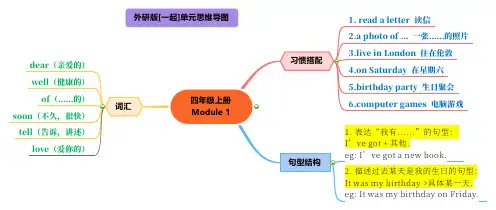

专业资料分享get →getting,四年级英语复习资料( 直接加ing )一、方向:play →playinggo straight on 直着走listen →listening, read →reading, turn left 向左转look →looking, row →rowing,turn right 向右转drink →drinking want →wanting,up↑向上down ↓向下cook→cooking二、缩写与完整形式:jump→jumping, wash→washing,draw→drawing, talk →talking,I ’m=I am, he ’s=he visit →visiting, count →counting, is, do→doing, watch →watching she’s=she is, it ’s=it is turn →turning,you’re=you are, w e’re=we五、重点短语句子are, they ’re=they arethere ’s=there is, 1、Here’s a dog. 这有一只小狗.there ’re=there are It ’s lost . 它迷路了have n’t=have not, can’t=can Excuse me .Where ’s No. 2 Parknot, don ’t=do not, Street ,please?isn ’t=is not, aren ’t=are Thank you very mush !十分感谢not, You are welcome !不客气三、单复数:behind the door 在门后面up the hill 上山I →we, you →you, down the hill 下山she/he/it →they man →men near the house 房屋附近people →people picture →pictures at the station 在车站friend →friends house →houses 2、Look at these pictures. 看这些图片。
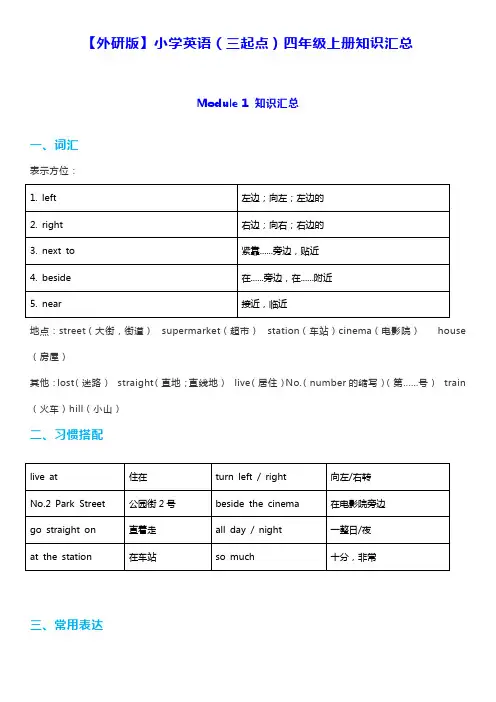
【外研版】小学英语(三起点)四年级上册知识汇总Module 1 知识汇总一、词汇表示方位:地点:street(大街,街道) supermarket(超市) station(车站)cinema(电影院) house (房屋)其他:lost(迷路) straight(直地;直线地) live(居住)No.(number的缩写)(第......号) train (火车)hill(小山)二、习惯搭配三、常用表达四、重点句型询问某人/物的位置:-- Where is ...?-- It’s + 其他.eg: 1. -- Where is the library? -- It’s near the park.2. -- Where is the cinema? -- Go straight and turn left.3. -- Where is my book?-- It’s on the desk.Module 2 知识汇总本模块学习目的:能够熟练询问并回答正在做的事情。
一、词汇动词:read(读,阅读) take(拍摄) listen(听)talk(说话,交谈)名词:picture(照片) children(孩子们)(child的复数形式)China(中国)其他:running(跑步) these(这些)二、习惯搭配三、重点句型1. 描述某人正在做某事:主语+ be动词(is / am / are)+ 动词-ing + 其他.eg: 1. I am watching TV.2. She is playing baseball.3. They are having a Chinese class.2. 询问某人正在做什么:-What + be动词(is / are)+ 主语+ doing?-主语+ be动词(is / am / are)+ 动词-ing + 其他.eg: 1. -What are you doing?-I’m listening to music.2. -What is Jack doing?-He is doing his homework.Module 3 知识汇总一、词汇1. kid 小孩2. can 能够,会3. see 看到4. interesting 有趣的5. thing 东西,物品;事情6. people 人,人们7. row 划(船) 8. dragon 龙9. men (man的复数形式)男人10. between 在……之间,在中间11. chess 国际象棋 12. drink 喝,饮13. clock 钟 14. hungry 饥饿的15. draw 画 16. jump 跳17. sing 唱歌 18. dance 跳舞二、习惯搭配三、惯用表达Me too. 我也一样。
![外研版小学英语四年级上册重点知识梳理[2]](https://uimg.taocdn.com/194c721814791711cc791769.webp)
一.单词1.point(单数)—points(复数)2.this(单数)—these(复数)二.短语1.have got 拥有三.句子1. Here’s a purple one.这儿有一个紫色的。
2. I’ve got twenty-six points.我有26分。
3. Have you got an elephant?你有一头大象吗?Yes,I have.(肯定回答)No,I haven’t.(否定回答)4.I am the winner.我是冠军。
四.语法an apple∕orange∕elephant一.单词1.l ost迷路2.where 哪里二.短语1. live in…居住在…2. excuse me 对不起,打扰3. go straight on 直着走4. turn left 向左转5. turn right 向右转6. next to 邻近的,在…旁边7. up the hill 上山8. down the hill下山9. at the station 在车站10. near the houses在房子旁边三.句子1. Excuse me,where is the supermarket,please?打扰一下,请问超市在哪里?2.I t’s next to a supermarket.它在超市附近。
3.T hank you so much非常感谢----You are welcome不客气一.单词(写出下列单词现在分词∕ing形式)1.w rite---writing2.t ake—taking3.s wim—swimming4.r un----running5.t alk—talking6.p lay—playing7.l isten—listening8.w atch—watching9.r ead---reading10.do—doing二.短语1.w rite a letter 写信2.t ake pictures 照相3.t alk to….和…交谈4.p lay with 玩,摆弄5.l isten to music听音乐6.w atch TV看电视7.d o my homework做我的家庭作业8.r ead a book 读书三.句子1.w hat are you doing?你正在干什么?--I am listening to music我正在听音乐2.what is he doing?---He is reading a book四.语法(现在分词)am∕is∕are+动词ing形式1.I am listening to music2. He is reading a bookModule4短语1.look at…..看….2.make dumplings 做饺子3.Here you are 给你4.make a cake 做蛋糕5.juice with ice 加冰块的果汁句子1.D o you want some rice?你想要一些果汁吗?2.C hinese fast food . 中式快餐3.L ook at that man .看那个男人4.W hat is he doing?他正在干什么?He is making noodles.他正在做面条5.N oodles with tomato and egg, please.西红柿鸡蛋面6.H ow much is it ?多少钱?7.It ’s very nice. 它十分美味语法1.Do you want some +食物?回答肯定:Yes,please否定: No, thank you2.how much is it?It ’s……..Module5句型1.Can you run fast ? 你能跑的快吗?2.I’m the winner .我是胜利者.3.Can you jump far ?你能跳的远吗?4.I’m afraid I can’t.我恐怕我不能.5.fly a kite 放风筝6.She is our star.她是我们的榜样7.Amy can’t run fast.艾米跑的不快语法:Can you ……?肯定:yes,I can否定:No,I can’t.Module 7短语1.in this photo 这张照片2.climb a tree 爬树3.under the tree 在树下4.play chess 下国际象棋5.look at 看句型1.There is a horse in this photo . 在照片中有一匹马2.There are some nice photos here. 这儿有一些漂亮的照片3.Who’s the girl?女孩是谁?4.I can’t see her face .我不能看见她的脸5.There is a panda in the photo . 照片中有一只熊猫语法1.There are some nice photos here. ----there are not any nice photos here2.----Are there any nice photos here 回答:yes , there are /isNo ,there aren ’t/isn’tModule 8短语6.t ime for bed 该睡觉了7.by plane 乘飞机8.be from 来自9.fly a kite 放风筝10.ride a horse 骑马11.row a boat 划船12.take pictures 照相13.at 5o’clock 在5点钟14.get up 起床句型1.Be going to do…2.We’re going to visit hainantomorrow.我们明天打算访问海南3.I’m from the UK. 我来自英国4.This is xiaoyong’bag.这是小明的包Module 9短语1.Sports day 运动日2.Have a sports 举办运动会3.the 100 metres 100米4.every day 每一天5.in the park 在公园里6.good luck 祝你好运e on 加油8.high jump 跳高9.long jump 跳远句子1.Are you going to run on sports day ?你打算在运动会上跑步吗?----Yes , I’m going to run the 100 metres .是的,我打算在运动会上跑100米2.Are you going to school?你打算去学校吗?---No ,I’m going to run in the park.不,我打算去公园跑步3.What are you going to do ?你们打算干什么?--We’re going to run .我们打算跑步4.How about you ?你呢?语法1.“Be going to +动词原形”准备或打算做某事2.Are you going to ……?--yes, I’m going to…--no, I’m going to3.What are you going to do ?--we are going to ….Module10短语1.Happy New Year 新年快乐2.have 吃3.Merry Christmas 圣诞节快乐4.give 给5.a Christmas tree 一棵圣诞树6.at the spring festival 在春节句型1.We have a big family dinner.我们有一个大的家庭宴会2.Here’s a book for you.这儿有一本书给你3.Wha t’s the spring festival?春节是什么?4.Here you are .给您5.Here’s your present.给你的礼物6.Christmas is coming.圣诞节快要来了7.What do you do at Christmas?在圣诞节级做什么?A : Do /does daming eat peanuts at Christmas?B :yes, he does./No , he doesn’t.语法Do /does +主语+动词+其他?肯答:yes,主语+do /does否答:No,主语+do /does。
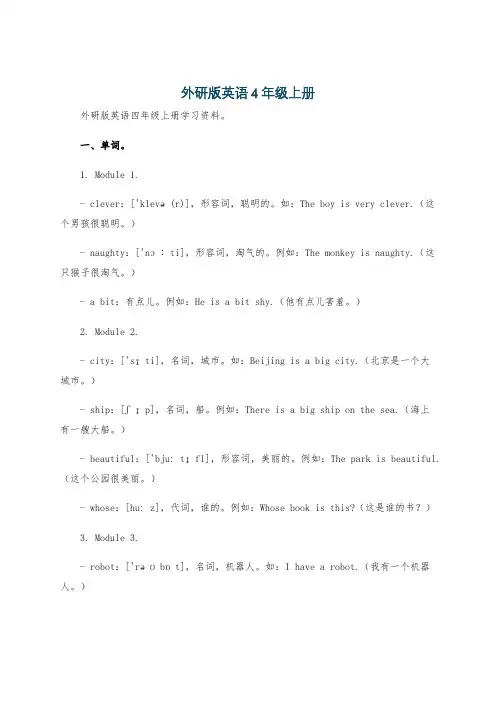
外研版英语4年级上册外研版英语四年级上册学习资料。
一、单词。
1. Module 1.- clever:['klevə(r)],形容词,聪明的。
如:The boy is very clever.(这个男孩很聪明。
)- naughty:['nɔːti],形容词,淘气的。
例如:The monkey is naughty.(这只猴子很淘气。
)- a bit:有点儿。
例如:He is a bit shy.(他有点儿害羞。
)2. Module 2.- city:['sɪti],名词,城市。
如:Beijing is a big city.(北京是一个大城市。
)- ship:[ʃɪp],名词,船。
例如:There is a big ship on the sea.(海上有一艘大船。
)- beautiful:['bjuːtɪfl],形容词,美丽的。
例如:The park is beautiful.(这个公园很美丽。
)- whose:[huːz],代词,谁的。
例如:Whose book is this?(这是谁的书?)3. Module 3.- robot:['rəʊbɒt],名词,机器人。
如:I have a robot.(我有一个机器人。
)- will:[wɪl],助动词(表示将来)。
例如:I will go to school tomorrow.(我明天将去上学。
)- everything:['evriθɪŋ],代词,所有事情。
例如:He can do everything.(他能做所有事情。
)- one day:(将来)有一天。
例如:One day, I will be a doctor.(有一天,我将成为一名医生。
)4. Module 4.- housework:['haʊswɜːk],名词,家务。
例如:I often do housework on Sunday.(我经常在星期天做家务。
外研版(三起)小学英语四年级上册Module 7重要知识点汇总一、单词1. horse 马2. sheep 羊,绵阳3. vegetable 蔬菜4. climb 爬,攀爬5. face 脸,面孔6. fruit 水果7. chicken 鸡8. bear 熊9. pig 猪二、习惯搭配1. there is 有,存在2. there are 有,存在3. have a look 看一看4. ride a horse 骑马5. run fast 快速地跑6. climb a tree 爬树7. some nice photos 一些好看的照片8. under the tree 在树下三、重点句型1. There is / are + 某人 / 某物 + 地点. 举例:There are some nice photos here.这里有一些好看的照片。
There is a horse in this photo.这张照片里有一匹马。
补充:①肯定句变否定句在be 后加not,如果句中有some,要把some 换成any。
举例:There isn’t a horse in this photo.这张照片里没有马。
There are some apples on the table.桌子上有一些苹果。
There aren’t any apples on the table.桌子上没有苹果。
②陈述句变一般疑问句:把be提到there 前。
如果句中有some,把some变成any。
举例:Are there any books in the room?房间里面有书吗?。
小学英语四年级上册课本知识点(外研版三年级起点)Module 1一、交际用语1、Excuse me:“对不起打扰一下”,用于询问对方事情等情况使用2、Thank you“谢谢你”(1)同义句:Thank you very much、Thank you so much、Thanks、Thanks a lot.(2)答句:You’re welcome.二、句型1、Here+be+名词:“这有…”,be用is还是are由名词的单复数决定eg:Here is a dog. Here are two dogs.三、单词及短语1、left“左”right“右”:on the left/right、on your left/right、turn left/right“向左/右转”2、live at No.2 Park Street:“住在公园路2号”(1)具体地址前的介词用at,表示具体地址的单词首字母要大写(2)No.是number的缩写,不要忘写“.”要与No“不”区分开3、方位介词next to、beside、near:(1)都表示“在旁边、附近”,位置关系由近到远依次为next to“紧挨着”、beside“在旁边”、near“附近”(2)提问用Where,如The supermarket is next to a cinema. Where is the supermarket?4、短语:go straight on“直走”、behind the tree“在树后”、at the station“在车站”、up the hill“在上山”、down the hill“在下山”Module 2一、句型1、现在进行时(1)主语+be doing+其他,表示某人正在做某事,如I’m reading a book.(2)动词形式是be doing,不要忘写be(3)动词原形变doing形式的规则①直接+ing,如read-reading②去e+ing(e不发音),如ride-riding、take-taking、dance-dancing、make-making③双写+ing(特殊记),如swim-swimming、run-running(4)标志词:now、Look! Listen!2、主语+like doing sth“喜欢做某事”,如I like playing football.二、单词及短语1、read“读”,read a book、read books“看书”不同的“看”用不同的动词:read books“看书”、watch TV“看电视”、look at these pictures“看这些照片”2、these“这些”,是this“这个”的复数形式,如Look at these pictures.3、take“拍摄”,take a picture、take pictures“拍照”4、children“孩子们”,单数是child5、listen“听”,listen to music“听音乐”,不要忘写to6、talk“交谈”,talk to my friend“与我的朋友谈话”,不要忘写to7、短语:play football“踢足球”、play basketball“打篮球”、play with a toy train“玩玩具火车”、fly a kite“放风筝”、ride a bike“骑自行车”、a book about China“一本关于中国的书”Module 3一、交际用语1、Me too.“我也是。
四上外研版英语知识点总结
以下是四上外研版英语的部分知识点总结:
1. 词汇:掌握有关学校、家庭、动物、季节等主题的词汇,如“classroom”、“home”、“cat”、“dog”、“spring”等。
2. 语法:学习现在进行时、一般现在时和特殊疑问句等语法知识,了解并列连词“and”和转折连词“but”的用法。
3. 语音:掌握字母组合“ai”、“ay”的发音规则,学习升降调的运用。
4. 阅读:能够读懂简单的英文小故事或短文,理解其中的情节和意义。
5. 写作:能够根据要求写简单的英文短文或信件,正确使用标点符号和大小写字母。
6. 听力:能够听懂语速较慢、发音清晰的英文短文或对话,获取其中的信息和细节。
7. 口语:能够进行简单的日常英语口语交流,如问候、介绍、购物等。
如需完整的四上外研版英语知识点总结,建议查阅教材教辅或咨询专业英语教师。
外研版四年级上册英语重点知识归纳一、单词。
1. 描述人物的单词。
- clever(聪明的),例如:The boy is clever.- nice(友好的;亲切的),如:She is a nice girl.- shy(害羞的),例如:The little girl is shy.- naughty(淘气的),如:My brother is naughty.- cool(酷的),例如:He looks cool.2. 关于家庭称谓的单词。
- father(父亲),口语中也可说dad。
- mother(母亲),口语中也可说mum。
- sister(姐妹)。
- brother(兄弟)。
- grandparent((外)祖父母),复数形式是grandparents。
- aunt(阿姨;姑姑;婶婶)。
- uncle(叔叔;伯伯;舅舅)。
3. 其他常用单词。
- call(称呼;叫;打电话),例如:You can call me Tom.- short(矮的;短的),与tall(高的)和long(长的)相对。
- strong(强壮的),例如:The man is strong.- friend(朋友),复数形式是friends。
- city(城市),例如:Beijing is a big city.二、短语。
1. 描述人物特征的短语。
- a bit(有点儿),如:He is a bit naughty.- a clever pupil(一个聪明的小学生),例如:He is a clever pupil.2. 家庭相关短语。
- my family(我的家庭),例如:This is my family.- on the phone(在打电话),如:She is talking on the phone.三、句型。
1. 描述人物特征的句型。
- This is... He/She is...(这是……他/她是……)- 例如:This is my sister. She is nice.- He/She is + 形容词(他/她是……的)- 如:He is cool.2. 询问人物身份的句型。
四年级英语复习资料一、Numbers数字:1 one,2 two,3 three,4 four,5 five,6 six,7 seven,8 eight,9 nine, 10 ten, 11 eleven,12 twelve, 13thirteen 14 fourteen, 15 fifteen, 16 sixteen, 17 seventeen, 18 eighteen,19 nineteen, 20 twenty, 21 twenty-one, 22 twenty-two, 23 twenty-three, 24 twenty- four25 twenty- five 26 twenty- six 27 twenty- seven 28 twenty- eight 29 twenty- nine30 thirty, 40 forty, 50 fifty, 60 sixty, 70 seventy, 80 eighty, 90 ninety, 100 one hundred .二、Colour颜色:red红色,green绿色,blue蓝色,yellow黄色,purple 紫色,pink粉色,white白色,orange橙色,black黑色,三、Directions方向:go straight on直着走turn left 向左转turn right 向右转up↑向上down↓向下四、Months月份:January一月February二月March三月April四月May五月June六月July七月August八月September九月October十月November 十一月December十二月五、缩写与完整形式:I’m=I am, he’s=he is,she’s=she is, it’s=it isyou’re=you are, we’re=we are,they’re=they arethere’s=there is, there’re=there arehave n’t=have not, can’t=can not,don’t=do not,isn’t=is not, aren’t=are not,六、单复数:I→we, you→you, she/he/it→they man→men people→people picture→pictures point→points friend→friends house→houses vegetable→vegetables thing→things party→parties child→children soup→soup 七、现在分词:(去e加ing )write→writing,take→taking,make→making,ride→riding,(双写加ing)swim→swimming run→running,get→getting,(直接加ing )play→playing listen→listening, read→reading, look→looking, row→rowing, drink→drinking want→wanting, cook→cooking jump→jumping, wash→washing, draw→drawing, talk→talking, visit→visiting, count→counting, do→doing, watch→watching turn→turning,八、重点短语句子1、Here’s a dog. 这有一只小狗. It’s lost .它迷路了Excuse me .Where’s No. 2 Park Street ,please?turn left 左转turn right右转go straight on直着走Thank you very mush!十分感谢You are welcome!不客气behind the door 在门后面up the hill上山down the hill下山near the house房屋附近at the station 在车站2、Look at these pictures.看这些图片。
外研版四年级英语上册各单元知识点汇总Module 1 ◎模块知识必备清单重点词汇straight 直地; 直线地left 左边; 向左; 左边的right 右边; 向右; 右边的lost 迷路的live 居住No. (number 的缩写)第……号street 大街, 街道supermarket 超市beside 在……旁边, 在……附近cinema 电影院station 车站train 火车hill 小山near 接近, 临近house 房屋重点短语go straight on 直着走excuse me 对不起, 打扰一下turn left 向左转turn right 向右转next to 紧靠……旁边, 贴近so much 十分, 非常重点句型1 Excuse me. 打扰一下。
解读: 该句子常用于问路、请教或插话之前, 用来引起对方的注意。
2 Where’s No. 2 Park Street, please? 请问公园大街2 号在哪儿?解读: 句型“Where’s (+the)+ 地点名词, please?”用来问路。
3 Turn left. /Go straight on. /Turn right. 向左转。
/ 直着走。
/ 向右转。
解读: 当有人向你问路时, 可用Turn left. /Go straight on. /Turn right. 来回答。
4 —Thank you so much! 非常感谢你!—You’re welcome! 不客气!解读: 常用的感谢语: Thanks. 谢谢。
/Thank you (very much/so much)! (非常)感谢你(们)!常用的感谢语答语: Not at all. 不用谢。
/That’s all right. 不用谢; 不客气。
/You’re welcome! 不客气!5 It’s at the station. 它在车站。
解读: “It’s+ 介词短语.”用于描述某物所在的位置。
外研版小学英语四年级上册知识梳理
文档编制序号:[KK8UY-LL9IO69-TTO6M3-MTOL89-FTT688]
Module1 一.单词
(单数)—points(复数)
(单数)—these(复数)
二.短语
1.have got 拥有
三.句子
1. Here’s a purple one.这儿有一个紫色的。
2. I’ve got twenty-six points.我有26分。
3. Have you got an elephant你有一头大象吗 Yes,I have.(肯定回答)
No,I haven’t.(否定回答)
4.I am the winner.我是冠军。
四.语法
an apple∕orange∕elephant
Module 2
一.单词
1.lost迷路哪里
二.短语
1. live in…居住在…
2. excuse me 对不起,打扰
3. go straight on 直着走
4. turn left 向左转
5. turn right 向右转
6. next to 邻近的,在…旁边
7. up the hill 上山
8. down the hill下山
9. at the station 在车站
10. near the houses在房子旁边
三.句子
1. Excuse me,where is the supermarket,please 打扰一下,请问超市在哪里
2.It’s next to a supermarket.
它在超市附近。
3.Thank you so much非常感谢
----You are welcome不客气
Module3
一.单词(写出下列单词现在分词∕ing形式)
1.write---writing
2.take—taking
3.swim—swimming
4.run----running
5.talk—talking
6.play—playing
7.listen—listening
8.watch—watching
9.read---reading
10.do—doing
二.短语
1.write a letter 写信
2.take pictures 照相
3.talk to….和…交谈
4.play with 玩,摆弄
5.listen to music听音乐
6.watch TV看电视
7.do my homework做我的家庭作业
8.read a book 读书
三.句子
1.what are you doing你正在干什么
--I am listening to music我正在听音乐
is he doing
---He is reading a book
四.语法(现在分词)
am∕is∕are+动词ing形式
1.I am listening to music
2. He is reading a book
Module4短语
1.l ook at…..看….
2.m ake dumplings 做饺子
3.H ere you are 给你
4.m ake a cake 做蛋糕
5.j uice with ice 加冰块的果汁
句子
1.Do you want some rice你想要一些果汁吗
2.Chinese fast food . 中式快餐
3.Look at that man .看那个男人
4.What is he doing他正在干什么
He is making noodles.他正在做面条
5.Noodles with tomato and egg, please.西红柿鸡蛋面
6.How much is it 多少钱
7. It ’s very nice. 它十分美味
语法
you want some +食物
回答肯定:Yes,please
否定: No, thank you
2.how much is it
It ’s……..
Module5句型
you run fast 你能跑的快吗
’m the winner .我是胜利者.
you jump far 你能跳的远吗
’m afraid I can’t.我恐怕我不能.
a kite 放风筝
is our star.她是我们的榜样
can’t run fast.艾米跑的不快
语法:
Can you ……
肯定:yes,I can
否定:No,I can’t.
Module 7短语
1.in this photo 这张照片
2.climb a tree 爬树
3.under the tree 在树下
4.play chess 下国际象棋
5.look at 看
句型
is a horse in this photo .
在照片中有一匹马
are some nice photos here.
这儿有一些漂亮的照片
’s the girl
女孩是谁
can’t see her face .
我不能看见她的脸
is a panda in the photo .
照片中有一只熊猫
语法
are some nice photos here.
----there are not any nice photos here there any nice photos here
回答:yes , there are /is
No ,there aren ’t/isn’t
Module 8
短语
6.t ime for bed 该睡觉了
7.b y plane 乘飞机
8.b e from 来自
9.f ly a kite 放风筝
10.ride a horse 骑马
11.row a boat 划船
12.take pictures 照相
13.at 5o’clock 在5点钟
14.get up 起床
句型
1.Be going to do…
2.We’re going to visit hainan tomorrow.我们明天打算访问
海南
3.I’m from the UK. 我来自英国
4.This is xiaoyong’bag.这是小明的包
Module 9
短语
day 运动日
a sports 举办运动会
100 metres 100米
day 每一天
the park 在公园里
luck 祝你好运
on 加油
jump 跳高
jump 跳远
句子
you going to run on sports day 你打算在运动会上跑步吗
----Yes , I’m going to run the 100 metres .是的,我打算在运动会上跑100米
you going to school你打算去学校吗
---No , I’m going to run in the park.不,我打算去公园跑步
are you going to do 你们打算干什么
--We’re going to run .我们打算跑步
about you 你呢
语法
1.“Be going to +动词原形”准备或打算做某事 you going to ……
--yes, I’m going to…
--no, I’m going to
are you going to do
--we are going to ….
Module10
短语
New Year 新年快乐
吃
Christmas 圣诞节快乐
给
Christmas tree 一棵圣诞树
the spring festival 在春节
句型
have a big family dinner.我们有一个大的家庭宴会’s a book for you.这儿有一本书给你
’s the spring festival春节是什么
you are .给您
’s your present.给你的礼物
is coming.圣诞节快要来了
do you do at Christmas在圣诞节级做什么
A : Do /does daming eat peanuts at Christmas
B :yes, he does./
No , he doesn’t.
语法
Do /does +主语+动词+其他
肯答:yes,主语+do /does
否答:No,主语+do /does。